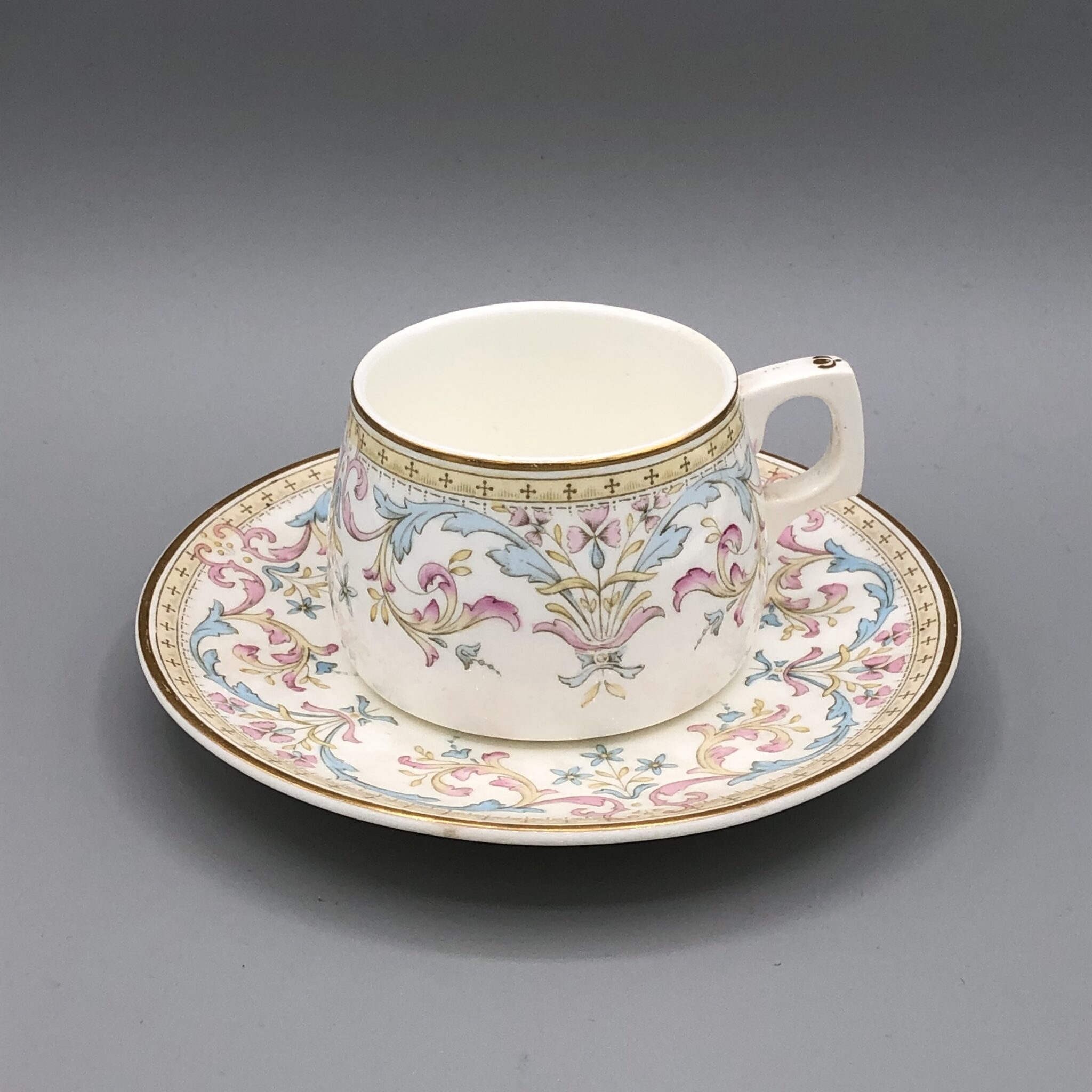How Coffee’s Global Influence Impacted America’s Foundations
A Collections Chronicles Blog
by Carley Roche, Collections Preservation Specialist
October 1, 2022
Happy International Coffee Day to all who enjoy this beloved beverage! As someone who is not a fan of coffee, I have often questioned why people love this bitter drink (and yes, I have tried different flavors and sugar additives). In search of an answer, I began researching the history of coffee, its spread around the world, and its impact on our society as a whole.
Spread of Coffee Around the World
Despite its worldwide popularity, the origin of coffee is relatively unknown. Oral traditions and written histories generally favor modern-day Ethiopia as the place where the stimulating effects of coffee were first discovered. A legend from the country tells of a goat herder named Kaldi who noticed his animals having increased energy after eating certain berries. Kaldi shared the energy boosting berries with his local abbot who then created a drink from the bean within the fruit. The abbot and fellow monastery workers could suddenly work through the entire night without feeling tired. News quickly spread of the energized and efficient monks with people wanting to try the drink themselves and thus coffee was born.
By the 15th century, coffee was well-known in the Arabian Peninsula. Coffee was cultivated for both private enjoyment at home and for trading with other businesses. The 16th century saw the drink’s expansion to countries such as Turkey, Egypt, Persia, and Syria. Annual religious pilgrimages to Mecca also helped broaden coffee’s appeal as visitors from all over the world brought back samples of the area’s stimulating beverage.
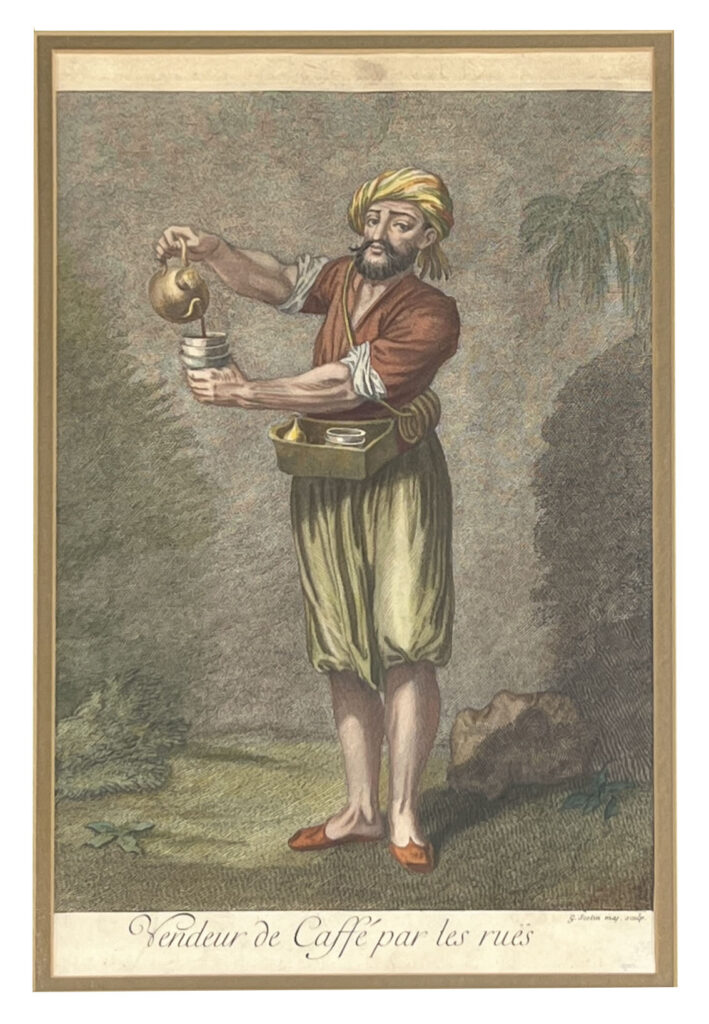
When coffee first came to Europe in the 17th century, it was met with initial hesitation. People feared it as the “bitter invention of satan,” which forced Pope Clement VIII to step in and take a stance on the new drink– officially bestowing it with his papal approval after tasting the drink. With a higher authority publicly accepting the drink, coffee quickly became a favored beverage across Europe and its colonies.
Famously, one particular colony did not prefer coffee until the late 18th century. While coffee did come to the New World with the Dutch in the 17th century, many American colonists still preferred to drink tea and beer socially while brewing coffee for personal enjoyment at home.
After King George III enacted the Tea Act of 1773, American colonists rebelled against the law with the Boston Tea Party which kicked off the American Revolution. With the previously preferred tea now a symbol of submission to the monarchy, American colonists quickly turned their backs on the drink in favor of coffee.
“Vendeur de Café par la rue” n.d. (originally early 18th century). Gift of Robert A. Bories, President, J. Aron and Co. 1996.033.0007
Rise of the Penny University
Even with coffee as one of the most sought after beverages around the world, how did this one drink influence society on an intellectual, political, and social level? In major European port cities, coffee houses began popping up that allowed men– as women were barred entry– to debate new ideas, discuss business, and, of course, gossip. An affordable entrance fee into these businesses provided men of differentIn economic backgrounds to mingle and engage in civil discourse earning them the nickname “penny universities.”
Despite coffee not becoming popular until the late 18th century in America, the drink had been well established by that point in the New World thanks to Dutch colonists. After Americans turned their backs on tea, the consumption of coffee increased and the need for coffee houses rapidly emerged across the new country. Similarly used as their European counterparts, American coffee houses allowed men to discuss politics, business, and society. One difference of the American coffee houses is that our country’s early laws and regulations were also upheld here with early court trials, general assemblies, and council meetings held in the main halls.
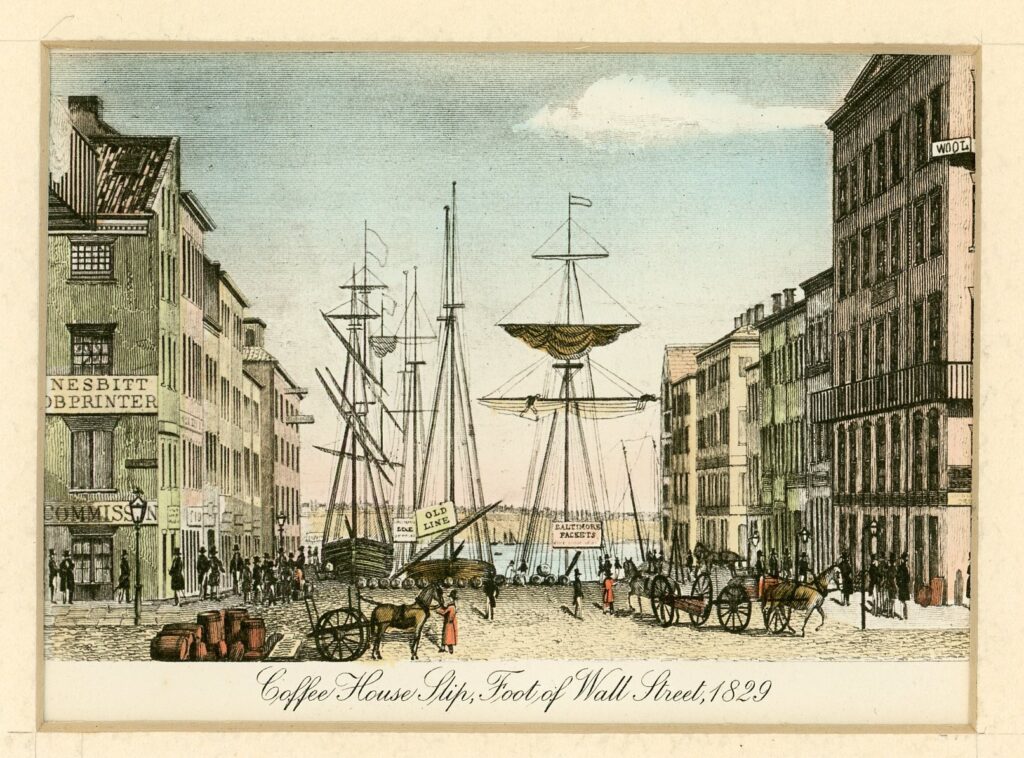
“Coffee House Slip, Foot of Wall Street, 1829” n.d. Seamen’s Bank for Savings Collection 1991.078.0044
As a global port, New York City became a major player in the coffee industry. So much so that Coffee House Slip emerged along Wall Street in the late 18th century. Here the buying, selling, and enjoyment of coffee took place by people of all social classes. American coffee houses grew alongside the country and played important roles in the establishment of some of our most basic laws and social policies today.
King’s Arms

Believed to be the first coffee house in New York City the King’s Arms sat on two acres of land on Broadway near Trinity Church and today’s Cedar Street.
John Hutchins bought this land on November 1, 1696 and built a house, which he later opened to the public and served coffee. As it was the only coffee house in New York it became affectionately known as “The Coffee House” rather than The King’s Arms.
The coffee house provided its visitors options to enjoy their drinks socially or in private.
Irma and Paul Milstein Division of United States History, Local History and Genealogy, The New York Public Library. “King’s Arms Tavern, now known as Atlantic Garden, Broadway” New York Public Library Digital Collections. Accessed September 20, 2022.
The two-story building provided private curtained booths in the main room, large meeting rooms on the second floor, and a rooftop seating area for guests to enjoy the view of New York Harbor. These aforementioned meeting rooms were frequented daily by local merchants, businessmen, and politicians to discuss deals and news with one another.
With the city’s continued expansion more coffee houses began to appear and so the popularity of The Coffee House began to dwindle. By 1763, The Kings Arms was referred to in public records as a tavern rather than a coffee house.
Burns’ Coffee House
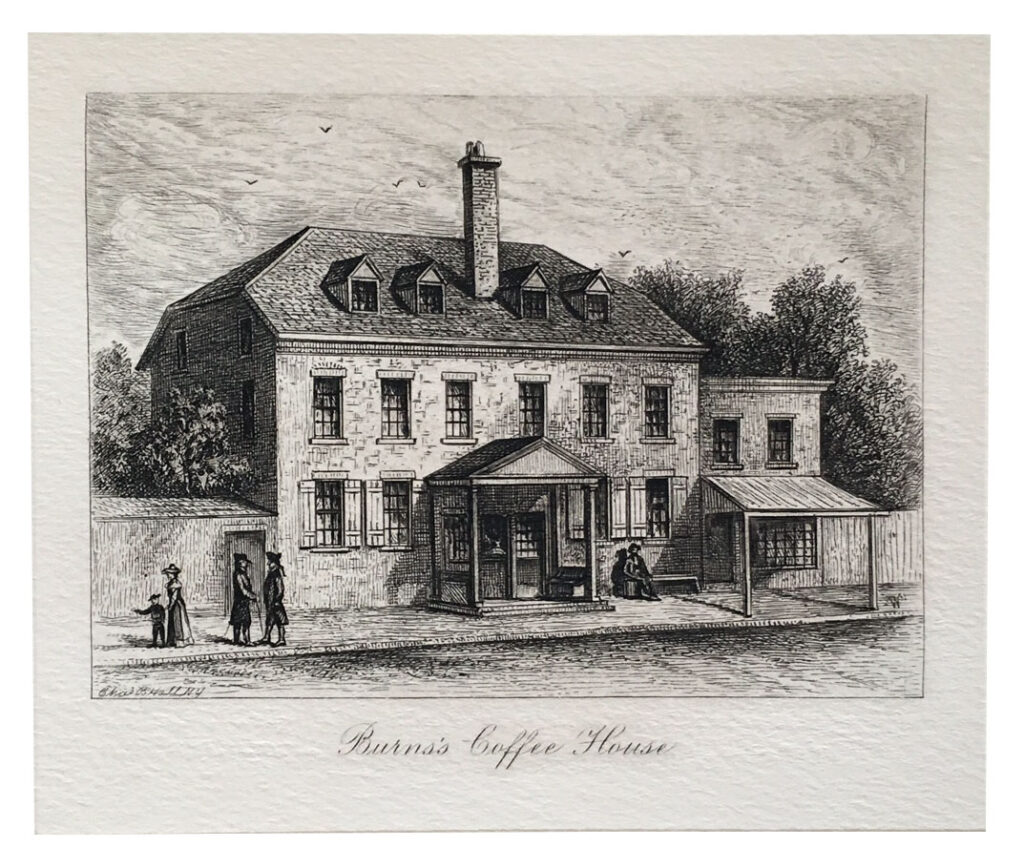
A two-story house located just across the street from Bowling Green played a significant role in the foundations of our country. Initially known as the DeLancey House, this building was converted into Burns’ Coffee House to provide people a space to socialize and conduct their business affairs. Much like the King’s Amrs, the second floor had a large meeting room while the main floor held private curtained-off booths.
But what was Burns’ Coffee House’s role during the early days of America? An otherwise simple and unremarkable coffee house of the day, it was here that New York merchants signed the New York Non-Importation Agreement on October 31, 1765.
“Burns’ Coffee House” 1890-1934. Gift of Joe Cantalupo 1978.007.0040
In direct opposition of the Stamp Act, the agreement stated the City would no longer purchase items from Britain. A highly patriotic act at the time, the same location years later is believed to have housed traitor Benedict Arnold after his defection from the American Military.
Tontine Coffee House
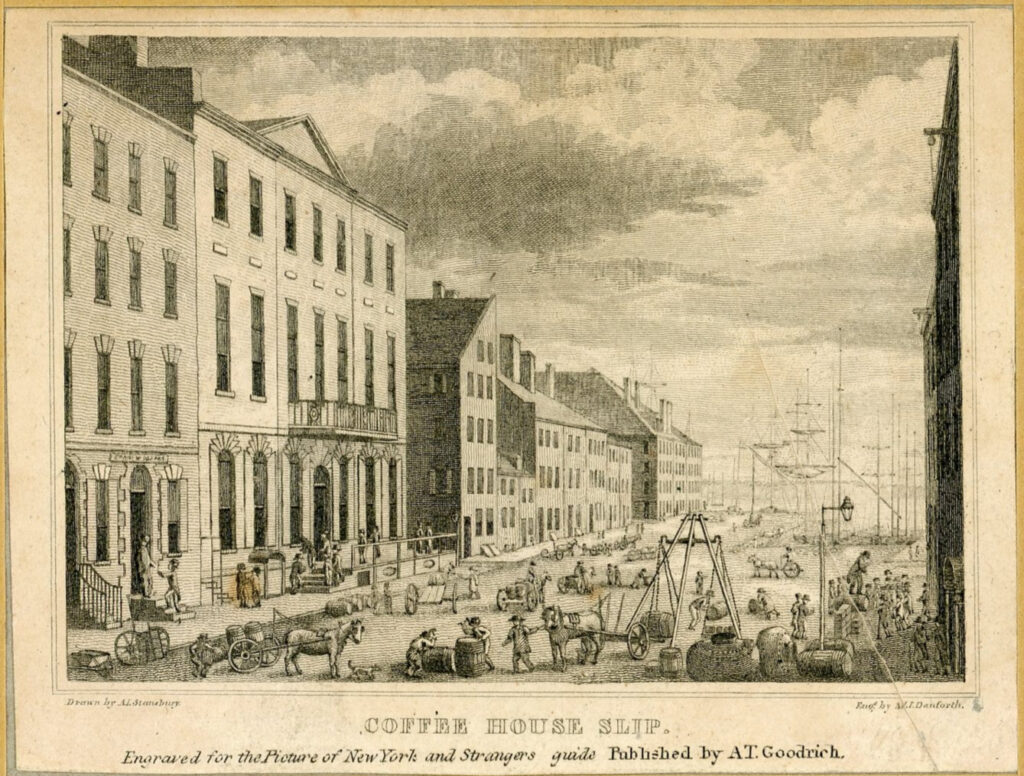
Early trading in New York was extremely chaotic. Merchants chose seemingly at random their prices depending on who they were dealing with. To combat this disorganized system 24 merchants met on May 17, 1792 under a buttonwood tree (an American Sycamore) on Wall Street.
These men signed the Buttonwood Agreement which provided rules and regulations to trading and is also the founding document of the New York Stock Exchange.
These individuals chose Tontine Coffee House to be their headquarters.
“Coffee House Slip.” ca. 1829. Seamen’s Bank for Savings Collection 1991.078.0038
At the corner of Water and Wall Streets, this coffee house was purchased as an investment in 1791 by approximately 150 New York City merchants in order to trade stock, register cargo, and, of course, socialize.
With the Buttonwood Agreement now regulating the market and the market headquarters within the Tontine Coffee House, this establishment became the first official headquarters of one of today’s largest stock exchanges in the world. By 1817, the entire stock market was within the walls of the coffee house making it one of the most important locations in American and global financial history.
Brown’s Coffee House and Dining Saloon

As we move into the 19th century, the coffee houses evolved with the times. Again with commerce, and politics thriving and growing in Lower Manhattan so too did businesses that fed and provided ample space for the men working.
Brown’s Coffee House and Dining Saloon opened its doors on August 12, 1846 at 71 Pearl Street. This four-story building shared its foundation with the Stadt Huys, the Dutch City Hall of New Amsterdam and the first City Hall in New York City. As a coffee house, this location catered to local politicians, merchants, and traveling businessmen.
Unlike earlier coffee houses, Brown’s also served as a saloon meaning it functioned as a full restaurant and bar as well. The ground floor provided the main room for eating and socializing while the second floor gave guests more private accommodations.
By the early 1900s, Brown’s Coffee House was no longer open, but it is unknown exactly when it closed. The building at 71 Pearl became residential and, unfortunately, fell into disrepair as the years went on.
“Brown’s Coffee House and Dining Saloon” ca. 1840. Museum Purchase 1995.003.0006
Conclusion
As a non-coffee drinker, it is quite staggering realizing the impact this one small bean has had on how we run our day-to-day lives. Its reach across history and culture cannot be understated as it has loomed in the background of colonization, revolutions, and the very foundations of American society. While I will not be joining you today as you have a cup (or two) to celebrate International Coffee Day, I can at least appreciate the influence this drink holds over the world.
If you drink a little too much coffee today and need to burn off the energy check out our latest walking tour on Urban Archive. See where history meets modern day as the locations of New York City’s early coffee houses are marked off with what replaces them today.
Additional Reading and Resources
Yale Law School. The Avalon Project. New York Merchants Non-importation Agreement; October 31, 1765.
The Brooklyn Daily Eagle. December 11, 1881. In A Coffee Cup: The history of Arabia’s inspirational bean.
Ukers, William H. 1922. All About Coffee. History of Coffee in Old New York.
The Brooklyn Daily Eagle. May 15, 1932. Again the Tontine Coffee House.
Olmert, Mike. Colonial Williamsburg. Spring 2001. Coffeehouses.
Avey, Tori. April 8, 2013. PBS. The Caffeinated History of Coffee.
Johnson, Ben. Historic UK. English Coffeehouses, Penny Universities.

